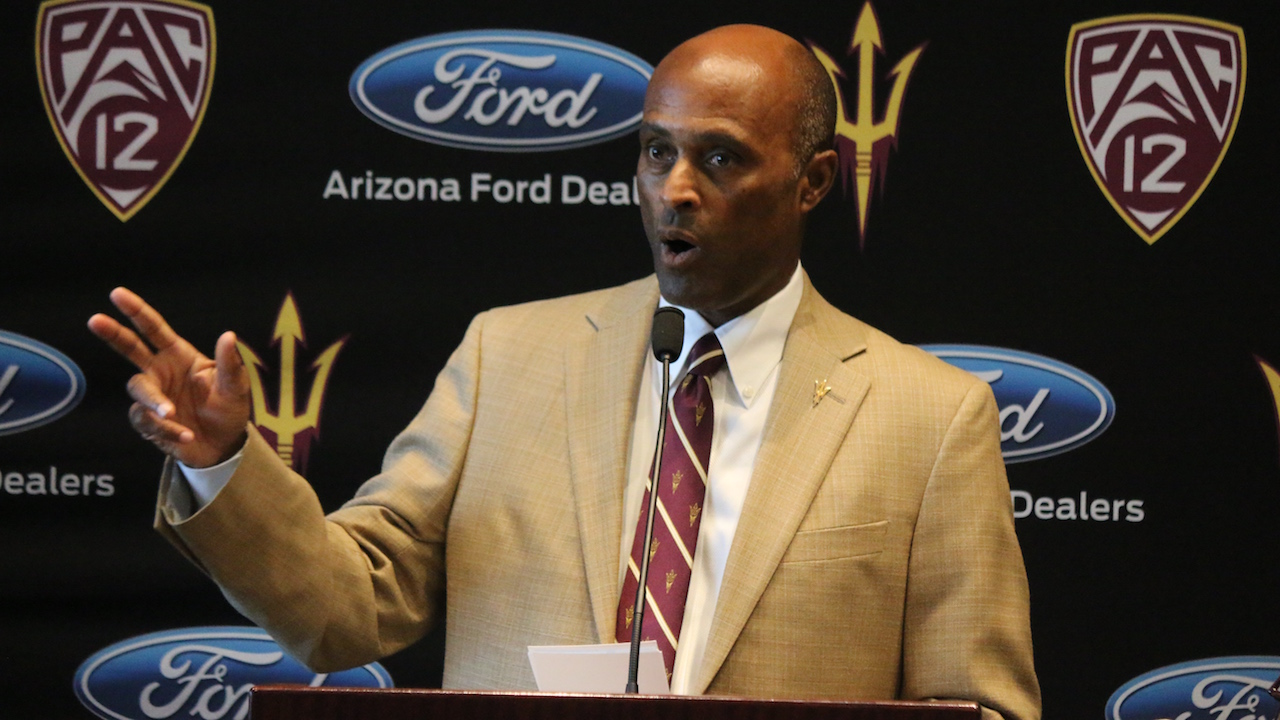We have added an interview that Jon and Brad Cesmat did earlier today. You can find it at the bottom of this story.
The NCAA’s committee on infractions will provide the epilogue in its own sweet time. But Arizona State has published the final chapter of the Herm Edwards Era. It’s a tale of horror and hubris, destruction and mayhem co-authored by president Michael Crow and athletic director Ray Anderson.
On Sunday, five days before the 2023 season opener, the Sun Devils announced a self-imposed postseason ban — a move that blindsided coach Kenny Dillingham and the players and left a barrage of questions that the authors of the decision, Crow and Anderson, have no intention of answering.
They will hide behind what the school called “our membership obligation (to the NCAA) to maintain the confidentiality of the matter.” As a result, Crow and Anderson “will not be commenting further at this time.”
Their obligations to the ASU players are a secondary concern.
Our thoughts on the deplorable decision …
— With the full sweep of the Edwards era now available for judgment, we’re left with a rhetorical question: Why in the world did Arizona State hire him in the first place, then implement the disastrous ‘New Leadership Model’?
Obviously, because Edwards was Anderson’s close friend and former business partner.
There is no other explanation, motivation or rationale. Never has been, in fact.
This was a personal joyride for the athletic director, and it left the football program in a state of devastation.
History will judge Anderson’s decision as an administrative failure for the ages.
— Why didn’t ASU impose the postseason ban prior to the 2022 season, or early in the 2022 season, when Edwards was still in charge?
That would have been appropriate on a number of levels given the dossier of evidence reportedly turned over to the NCAA. Instead, the Sun Devils cut ties with Edwards after a sluggish start, appointed an interim coach and staggered through a wasted year ideally suited for a bowl ban.
That level of waste has now doubled with the removal of the 2023 postseason.
Based on the available evidence, the only explanation for refusing to self-impose last year is that Anderson didn’t want to further tarnish Edwards’ legacy.
Then he doubled down on their friendship by reaching a $4.4 million departure settlement with Edwards.
That’s right. The school paid $4.4 million to a coach whose program was under NCAA investigation for major recruiting violations during the COVID dead period.
Obviously, Crow signed off on the settlement. But we’re left to ask: Where was the fiduciary obligation to the university? Spending $4.4 million on a buyout when they quite possibly could have spent $0, for terminating Edwards with cause, strikes us as a fiscally irresponsible move.
— Why wait until five days before the season opener — and until school had already started — to announce the postseason ban? What had changed by Aug. 27 that wasn’t evident in the spring, before the transfer portal closed?
Did Crow and Anderson purposefully wait this long so the players couldn’t leave en masse. Was it a cold, calculated move to leave the players with no recourse?
It’s a reasonable question to ask given the lack of logical alternatives.
— Another reasonable question: Why impose the postseason ban at all?
In ruling on the Tennessee recruiting scandal last month, the NCAA signaled a newfound aversion to issuing bowl bans as part of its penalty matrix:
“Ordinarily, a case of this magnitude would warrant and require a postseason competition ban. But these are not ordinary times in college athletics. The landscape has evolved in many ways and continues to do so. As it relates to the infractions program, the membership has communicated its intent to shift away from penalties that impact student-athletes who were not involved in violations.”
Instead of issuing a bowl ban for an unprecedented number of recruiting violations, the NCAA simply fined Tennessee $9 million and allowed the football program to proceed with standard competition and postseason access.
And yet here’s Arizona State, with the Tennessee ruling fresh out of the NCAA oven, opting to self-impose a bowl ban.
Which suggests the evidence against Edwards and his staff is absolutely mountainous.
Which begs the question: Why didn’t ASU impose the bowl ban at some point during the 2021 or 2022 seasons, when Edwards was still the head coach?
If Anderson and Crow knew that Thor’s hammer was inevitable and believed a proactive approach might mitigate the impact, why not take that step prior to this week?
— Smoke billowed from Dillingham’s nostrils Sunday when he addressed the media following practice, and understandably so. He was clearly caught unaware a postseason ban was coming and now must guide his team through a fall with no postseason carrot.
Dillingham knows this decision undercuts the faith that his players — and prospective players — will have in Arizona State and in the culture he’s trying to build.
He knows it will give rival programs ample material to negatively recruit against the Sun Devils.
He knows the multi-year damage it creates.
And now he knows his boss, Anderson, cannot be trusted. Not for an instant.
— We are left with so many questions as Anderson and Crow hide behind their “obligation” to the NCAA to maintain “confidentiality,” and the reality is they might never offer answers (satisfactory or otherwise).
But their actions since the scandal broke in the summer of 2021 suggest a desire to place a personal relationship above what was best for the school and the athletes.
For when it comes to Arizona State football, administrative accountability does not exist.
Anderson remains employed, with a contract that pays him about $1 million annually (plus bonuses) through the winter of 2026.
Edwards? He has $4.4 million in the bank and is back working for ESPN as a studio analyst.
As one industry source noted on the timing of the ASU announcement: “It’s utterly unconscionable.”
The only victims of this awful tale are the innocent, because that’s how Anderson and Crow roll.
Editors note-Here is Jon and Sports360az’s Brad Cesmat diving deep into the Arizona State story. This interview took place Monday morning.
*** Send suggestions, comments and tips (confidentiality guaranteed) to pac12hotline@bayareanewsgroup.com or call 408-920-5716
*** Follow me on Twitter: @WilnerHotline
*** Pac-12 Hotline is not endorsed or sponsored by the Pac-12 Conference, and the views expressed herein do not necessarily reflect the views of the Conference.
Related posts:
 Wilner Hotline: Breaking down the Pac-12 stretch-run schedules, a ratings gem, Homecoming dates and more
Wilner Hotline: Breaking down the Pac-12 stretch-run schedules, a ratings gem, Homecoming dates and more 
(AP Photo/Ralph Freso, File)
Pac-12 picks: Utah, USC cover on the road while Arizona meets the moment and OSU rolls on
Arizona guard Kerr Kriisa (25) (AP Photo/Rick Scuteri)
Pac-12 MBB projections: UCLA, Arizona heavy favorites to control the conference race Pac-12 rewind: Big Three roll as Oregon falters, home teams dominate and Mick Cronin rails against early NCAA seed
Pac-12 rewind: Big Three roll as Oregon falters, home teams dominate and Mick Cronin rails against early NCAA seed
